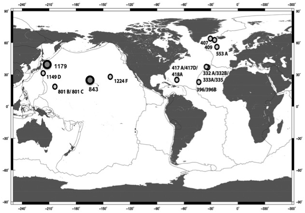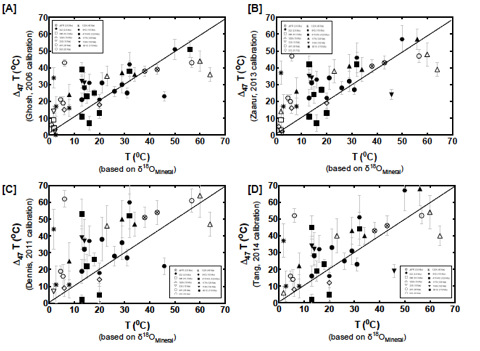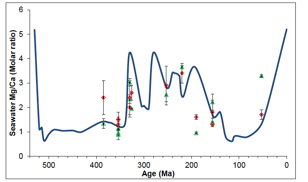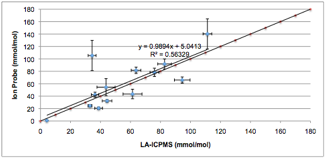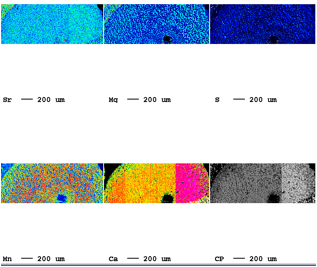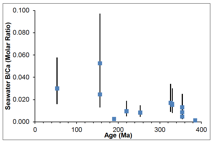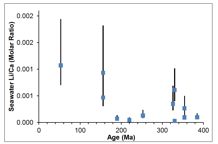Reports: ND252977-ND2: Evolution of Seawater Mg/Ca Ratios: New Constraints from the Carbonate 'Clumped Isotope' Thermometer
Edwin Schauble, PhD, University of California, Los Angeles
The focus of our New Directions Grant from the American Chemical Society (ACS-52977-ND2) was to place new constraints of the evolution of seawater temperature and Mg/Ca ratios over Phanerozoic and Cenozoic timescales. The chemical evolution of the oceans links the ocean-atmosphere system and the evolution of life throughout Earth history. The ratio of magnesium to calcium (Mg/Ca) in seawater is controlled over long geological timescales by processes such as spreading rates of plates, continental weathering, carbonate sedimentation, and diagenesis. Seawater Mg/Ca fundamentally controls biomineralization by making the biological precipitation of calcite or aragonitic shells by marine calcifiers more or less thermodynamically favorable. Previous reconstructions of secular changes in seawater Mg/Ca roughly coincide with switches from “calcite” to “aragonite” seas; however, disagreements persist on the magnitude and timing of these changes. In part this is due to uncertainties over the impact of ocean temperature and diagenesis on the carbonate archives used for seawater reconstructions.
Over the past year, with ACS-PRF support, we initiated two research projects with interlinked objectives:
1. Using carbonate “clumped” isotope paleothermometry to constrain mineralization temperatures of mid-ocean ridge vein carbonates previously used to reconstruct Phanerozoic seawater chemistry (Coggon et al., 2010, Rausch et al., 2013).
2. Using a combination of microprobe techniques- Secondary Ion Mass Spectrometry (SIMS), Laser Ablation Inductively Coupled Mass Spectrometry (LA-ICPMS), electron probe based mapping, and sophisticated scanning electron (SEM) and X-ray imaging to create integrated records of Phanerozoic ocean chemistry (mainly Mg/Ca, Sr/Ca, Li/Ca, B/Ca) from a suite of echinoid fossils previously used to reconstruct seawater Mg/Ca (Dickson, 2002).
Figure 1: Map of Ocean Drilling Program sites for vein calcite samples.
We have investigated over 50 carbonate veins from 14 drill sites in the Atlantic and Pacific (Fig. 1). Most of these samples were obtained from horizons that were already extensively explored (Coggon 2010, Rausch 2013). Sample powders were obtained by micro-drilling or handpicking crushed core material. Two or more replicates of these powders were analyzed for clumped isotope compositions. The same powders were also analyzed for Mg/Ca, Li/Ca, B/Ca (and Fe, Al, Ti) using solution based ICP-MS. Clumped isotope temperatures of these veins range between 6-60°C. Clumped isotope temperatures also allow us to calculate the d18O of mineral formation waters.
Figure 2: Comparing temperature reconstructions of carbonate veins. Clumped isotope temperatures are almost all warmer than those based on d18O, which assume seawater d18O (Coggon et al. 2010 and Rausch et al., 2013). This suggests that a common assumption used in previous studies -- that veins predominantly form from fluids with d18O equivalent to seawater -- may be substantially incorrect in many samples.
Clumped isotopes indicate that most veins formed and/or later recrystallized in high temperature hydrothermal fluids. Only a handful of samples show temperatures and d18O compositions consistent with formation from seawater (Fig. 2). Previous seawater reconstructions assumed veins primarily formed from fluids with seawater d18O in order to calculate formation temperatures (Coggon et al 2010, Rausch et al 2013). Clumped isotope data call that assumption into question in most cases, but also identify a subset of vein samples where the assumption may be correct. In this subset of low temperature veins we are able to put additional constraints on Mg/Ca and Sr/Ca ratios (Fig 3). Clumped isotope reconstructions provide independent constraints on vein formation temperatures that are critical for understanding their diagenetic histories.
Figure 3: Reconstructed Sr/Ca and Mg/Ca in formation fluids; open circles show previous results, and solid circles show our samples with formation temperatures consistent with seawater. Solid black stars represent averages of all sites. Solid lines depict modeled Sr/Ca and Mg/Ca evolution curves by Wallmann (2001). The broken line in the right-hand panel represents a model Mg/Ca evolution (Hardie, 1996). Vertical solid lines indicate echinoderm data from Dickson (2002 & 2004).
To address project goal 2 we conducted SIMS, LA-ICPMS and electron probe mapping analyses (Fig 4-7) on a suite of echinoid fossils previously used to reconstruct seawater Mg/Ca using electron microprobe measurements (Dickson, 2002). Our SIMS results show reasonable agreement. Further agreement between SIMS and LA-ICPMS measurement of Mg/Ca give confidence regarding the use of this combination technique. However, electron probe elemental mapping of some samples showed structural features with significant compositional variation. These should be taken into account in seawater reconstructions. We also collected trace element data, including B/Ca, Li/Ca (Figures 7) and Sr/Ca, to enable future work on changes in weathering fluxes and the oceanic carbonate system over time, including links to secular changes in seawater Mg/Ca. We also measured cultured modern echinoderms that will allow us to understand fossil compositions and diagenetic history in a robust manner.
Figure 4. Seawater Mg/Ca reconstructions based on echinoid fossils. Previous electron microprobe-based reconstructions of Dickson are represented by red diamonds; our SIMS analyses are plotted as green triangles.
Figure 5. Mg/Ca in SIMS- vs. LA-ICPMS analyses of echinoid fossils.
Figure 6. Electron probe elemental mapping of echinoid fossils.
Figure 7. Seawater B/Ca and Li/Ca reconstructions based on SIMS analyses of echinoid fossils.
Two manuscripts are in preparation based on this work:
Bhattacharya A., Eagle R., and Doss W. Revaluation of mid-ocean ridge carbonate vein based seawater reconstructions over the Phanerozoic using clumped isotope thermometry.
Bhattacharya A. Eagle R. Dickson J., and Ries J. Micro-analyses of echinoid fossils to revise records of Phanerozoic seawater elemental composition.
Impact on Career Advancement
This grant supported postdoctoral scientist Atreyee Bhattacharya, who is now starting a faculty position at the University of Colorado. Project participant Eagle to developed a completely new area of research of the geologic history of seawater. Undergraduate student Jessica Canat De Guzman, who is from an underrepresented background, also gained valuable laboratory experience.
1 982 5600 Department of Earth, Planetary and Space Sciences, 46
13 6569 14.0 Normal 0 false false false EN-US JA X-NONE

